2015 Peugeot Partner Drive
[x] Cancel search: DrivePage 4 of 292

2
Partner-2-VU_en_Chap00a_Sommaire_ed01-2015
Key 18
Remote control 18
Alarm
20
Doors
21
Rear roof flap
25
T
ailgate 26
Central locking
27
Instrument panel
28
Date and time
29
W
arning lamps
32
Fuel gauge
40
Coolant
40
Under-inflation detection
41
Service indicator
43
Lighting dimmer
44
Steering wheel
adjustment
45
Manual gearbox
45
Gear shift indicator
46
6-speed electronic
gearbox
47
Stop & Start
49
Starting and stopping
52
Hill start assist
53
Driving
recommendations
54Lighting
55
Wipers
58
Trip computer
60
Cruise control
61
Speed limiter
64
Heating /
Air conditioning
manual
67
digital
69
Demisting and
defrosting
72
Front seats
74
Individual passenger
seat
75
Multi-Flex bench seat
76
Configurations
78
Front fittings
79
Courtesy lamps
81
Crew cab
82
Load space
84
Roof bars
86
Mirrors
87
Electric windows
89
READY TO SET OFF SAFETY
Exterior 5
Interior 6
left hand drive
6 right hand drive
7
Instruments and controls
8 left hand drive
8 right hand drive
1
1
Technical data - Maintenance
12 Horn
90
Hazard warning lamps 90
Parking brake
90
Parking sensors
91
Reversing camera
93
Anti-lock braking
system (ABS)
94
EBA
94
ASR and DSC
95
Grip control
96
Active City Brake
98
Seat belts
102
Airbags
104
Carrying children
108
Deactivating the passenger's
front airbag
1
10
Recommended seats
1
13
Installation
1
14
EASE OF USE and
COMFORT
ECO-DRIVING
Environment 15
Eco-driving 16
The "Visual Search"
(visual
index) section
assists you in finding the
controls and functions
and their associated page
numbers on the schematic
outlines of the vehicle.
Instruments and controls
left hand drive
13 right hand drive
14
4-14
15-17 18-54
55-8990-116
OVERVIEW
1.
2. 3.
4. 5.
Contents
Page 5 of 292
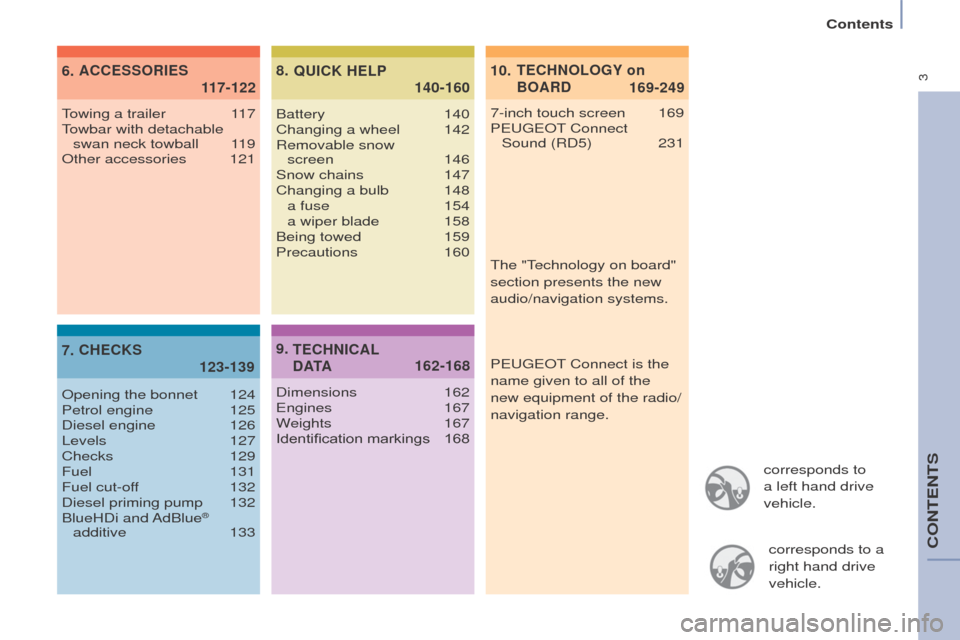
3
Partner-2-VU_en_Chap00a_Sommaire_ed01-2015
corresponds to
a left hand drive
vehicle.corresponds to a
right hand drive
vehicle.
TECHNOLOGY on
BOARD
ACCESSORIES
CHECKS QUICK HELP
7-inch touch screen 169
P EUGEOT Connect
Sound (RD5)
231
T
owing a trailer
1
17
Towbar with detachable swan neck towball
1
19
Other accessories
121
Opening the bonnet
124
Petrol engine
125
Diesel engine
126
Levels
127
Checks
129
Fuel
131
Fuel cut-off
132
Diesel priming pump
132
BlueHDi
and AdBlue
®
additive
133 Battery
140
Changing a wheel
142
Removable snow
screen 146
Snow chains
147
Changing a bulb
148 a fuse
154 a wiper blade
158
Being towed
159
Precautions
160
TECHNICAL
D ATA
Dimensions 162
Engines 167
Weights
167
Identification markings
168The "T
echnology on board"
section presents the new
audio/navigation systems.
P EUGEOT
Connect is the
name given to all of the
new equipment of the radio/
navigation range.
117-122
123-139 140-160
162-168 169-249
6.
7. 8.
9. 10.
Contents
CONTENTS
Page 15 of 292
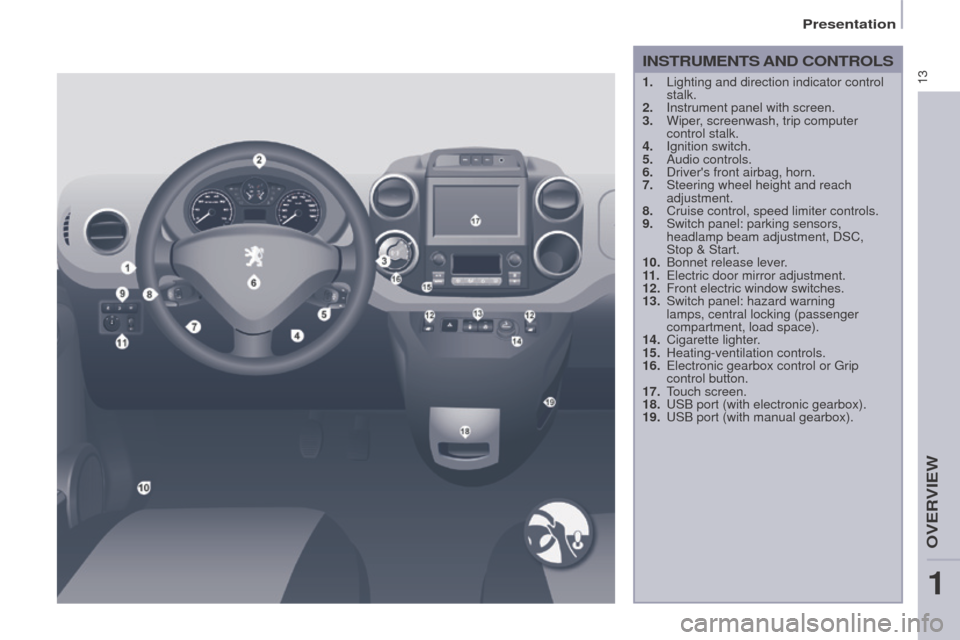
13
Partner-2-VU_en_Chap01_vue-ensemble_ed01-2015
INSTRUMENTS AND CONTROLS
1. Lighting and direction indicator control
stalk.
2.
Instrument panel with screen.
3.
Wiper
, screenwash, trip computer
control stalk.
4.
Ignition switch.
5.
Audio controls.
6.
Driver's front airbag, horn.
7.
Steering wheel height and reach
adjustment.
8.
Cruise control, speed limiter controls.
9.
Switch panel: parking sensors,
headlamp beam adjustment, DSC,
Stop
& Start.
10.
Bonnet release lever
.
11 .
Electric door mirror adjustment.
12.
Front electric window switches.
13.
Switch panel: hazard warning
lamps, central locking (passenger
compartment, load space).
14.
Cigarette lighter
.
15.
Heating-ventilation controls.
16.
Electronic gearbox control or Grip
control button.
17.
T
ouch screen.
18.
USB port (with electronic gearbox).
19.
USB port (with manual gearbox).
1
OVERVIEW
Presentation
Page 16 of 292
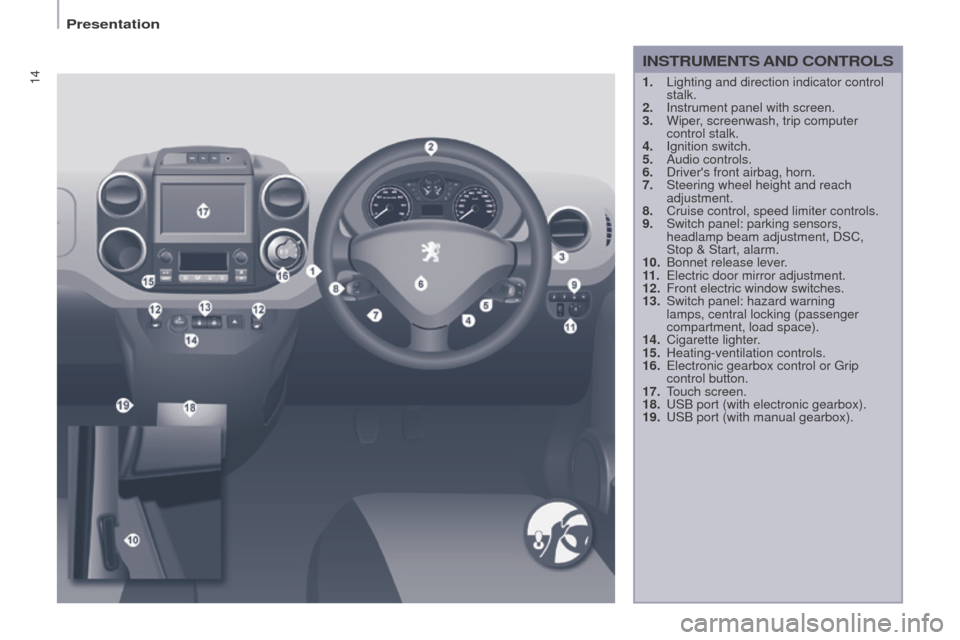
14
Partner-2-VU_en_Chap01_vue-ensemble_ed01-2015
1. Lighting and direction indicator control
stalk.
2.
Instrument panel with screen.
3.
Wiper
, screenwash, trip computer
control stalk.
4.
Ignition switch.
5.
Audio controls.
6.
Driver's front airbag, horn.
7.
Steering wheel height and reach
adjustment.
8.
Cruise control, speed limiter controls.
9.
Switch panel: parking sensors,
headlamp beam adjustment, DSC,
Stop & Start, alarm.
10.
Bonnet release lever
.
11 .
Electric door mirror adjustment.
12.
Front electric window switches.
13.
Switch panel: hazard warning
lamps, central locking (passenger
compartment, load space).
14.
Cigarette lighter
.
15.
Heating-ventilation controls.
16.
Electronic gearbox control or Grip
control button.
17.
T
ouch screen.
18.
USB port (with electronic gearbox).
19.
USB port (with manual gearbox).
INSTRUMENTS AND CONTROLS
Presentation
Page 17 of 292
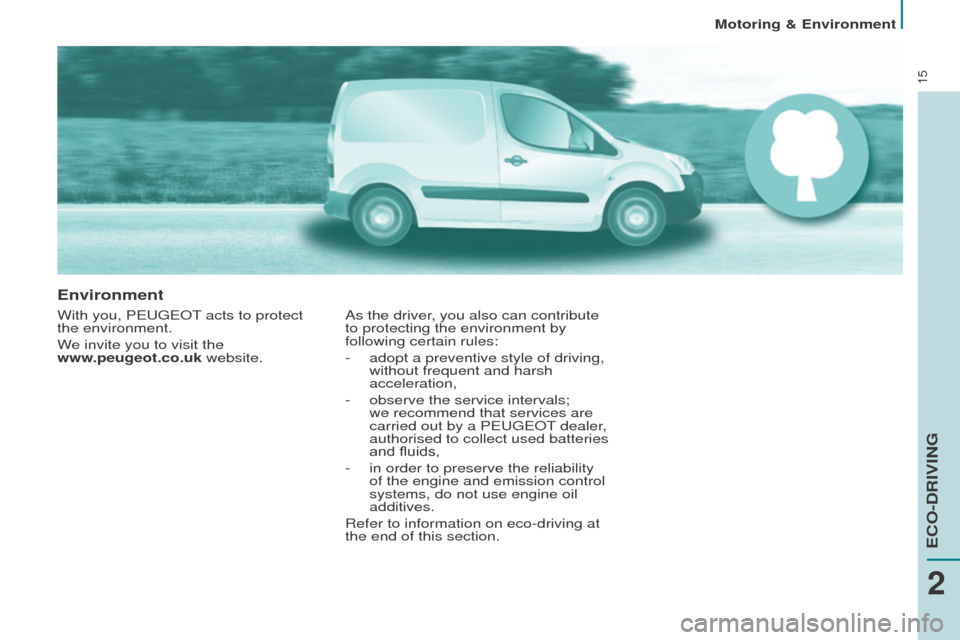
15
Environment
With you, PEUGEOT acts to protect
the environment.
We invite you to visit the
www.peugeot.co.uk website.As the driver, you also can contribute
to protecting the environment by
following certain rules:
-
adopt a preventive style of driving,
without frequent and harsh
acceleration,
-
observe the service intervals;
we recommend that services are
carried out by a PEUGEOT
dealer,
authorised to collect used batteries
and fluids,
-
in order to preserve the reliability
of the engine and emission control
systems, do not use engine oil
additives.
Refer to information on eco-driving at
the end of this section.
2
ECO-DRIVING
Motoring & Environment
Page 18 of 292
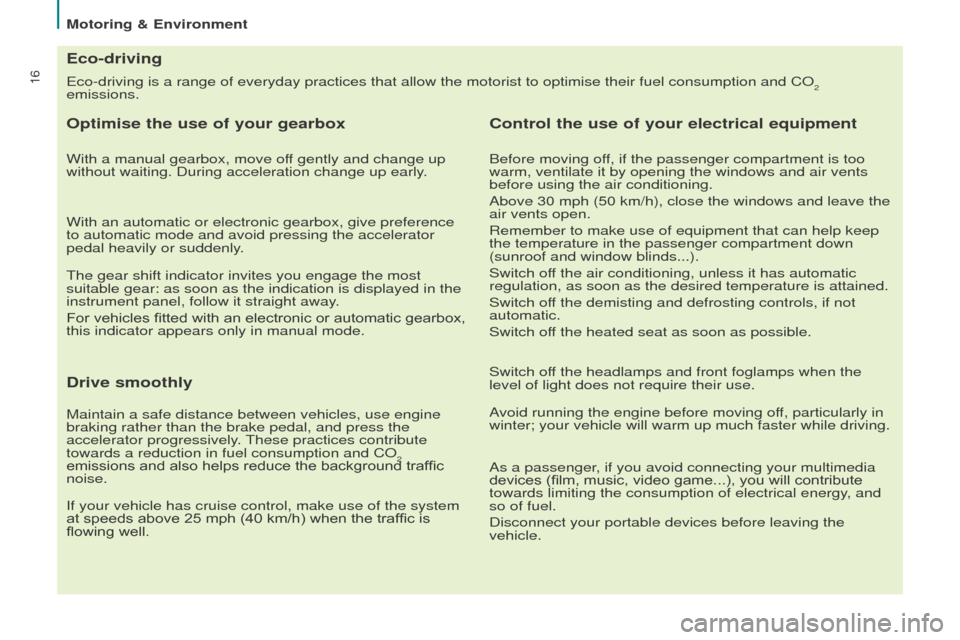
16Eco-driving is a range of everyday practices that allow the motorist to \
optimise their fuel consumption and CO2
emissions.
Eco-driving
Optimise the use of your gearbox
With a manual gearbox, move off gently and change up
without waiting. During acceleration change up early.
With an automatic or electronic gearbox, give preference
to automatic mode and avoid pressing the accelerator
pedal heavily or suddenly.
The gear shift indicator invites you engage the most
suitable gear: as soon as the indication is displayed in the
instrument panel, follow it straight away.
For vehicles fitted with an electronic or automatic gearbox,
this indicator appears only in manual mode.
Drive smoothly
Maintain a safe distance between vehicles, use engine
braking rather than the brake pedal, and press the
accelerator progressively. These practices contribute
towards a reduction in fuel consumption and CO
2
emissions and also helps reduce the background traffic
noise.
If your vehicle has cruise control, make use of the system
at speeds above 25 mph (40 km/h) when the traffic is
flowing well.
Control the use of your electrical equipment
Before moving off, if the passenger compartment is too
warm, ventilate it by opening the windows and air vents
before using the air conditioning.
Above 30 mph (50 km/h), close the windows and leave the
air vents open.
Remember to make use of equipment that can help keep
the temperature in the passenger compartment down
(sunroof and window blinds...).
Switch off the air conditioning, unless it has automatic
regulation, as soon as the desired temperature is attained.
Switch off the demisting and defrosting controls, if not
automatic.
Switch off the heated seat as soon as possible.
Switch off the headlamps and front foglamps when the
level of light does not require their use.
Avoid running the engine before moving off, particularly in
winter; your vehicle will warm up much faster while driving.
As a passenger, if you avoid connecting your multimedia
devices (film, music, video game...), you will contribute
towards limiting the consumption of electrical energy, and
so of fuel.
Disconnect your portable devices before leaving the
vehicle.
Motoring & Environment
Page 19 of 292

17
Limit the causes of excess consumption
Spread loads throughout the vehicle; place the heaviest
items in the bottom of the boot, as close as possible to the
rear seats.
Limit the loads carried in the vehicle and reduce wind
resistance (roof bars, roof rack, bicycle carrier, trailer...).
Use a roof box in preference.
Remove roof bars and roof racks after use.
At the end of winter, remove snow tyres and refit your
summer tyres.
Observe the recommendations on maintenance
Check the tyre pressures regularly, when cold, referring to
the label in the door aperture, driver's side.
Carry out this check in particular:
-
before a long journey
,
-
at each change of season,
-
after a long period out of use.
Don't forget the spare wheel and the tyres on any trailer or
caravan.
Have your vehicle serviced regularly (engine oil, oil
filter
, air filter, passenger compartment filter...) and
observe the schedule of operations recommended in the
manufacturer's service schedule.
With a BlueHDi Diesel engine, if the SCR system is faulty
your vehicle becomes polluting ; go to a PEUGEOT
dealer or a qualified workshop without delay to have the
emissions of nitrous oxides brought back to the legal level.
When refuelling, do not continue after the third cut-off of
the nozzle to avoid any overflow.
At the wheel of your new vehicle, it is only after the first
1 800 miles (3 000 kilometres) that you will see the fuel
consumption settle down to a consistent average.
2
ECO-DRIVING
Motoring & Environment
Page 23 of 292
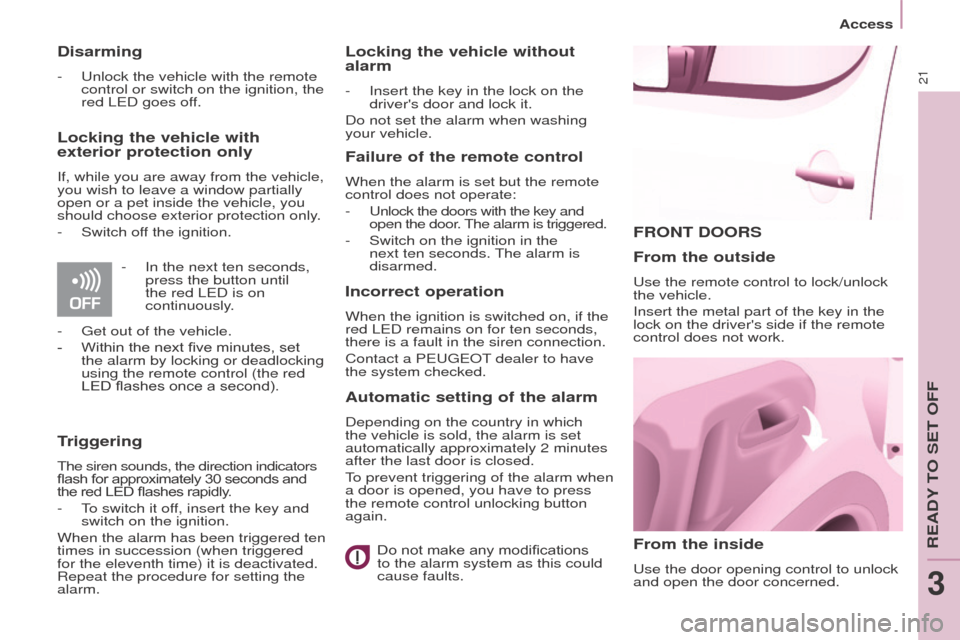
21
Partner-2-VU_en_Chap03_Pret-a-partir_ed01-2015
FRONT DOORS
From the inside
Use the door opening control to unlock
and open the door concerned.
From the outside
Use the remote control to lock/unlock
the vehicle.
Insert the metal part of the key in the
lock on the driver's side if the remote
control does not work.
Disarming
- Unlock the vehicle with the remote
control or switch on the ignition, the
red LED goes off.
Locking the vehicle with
exterior protection only
If, while you are away from the vehicle,
you wish to leave a window partially
open or a pet inside the vehicle, you
should choose exterior protection only.
-
Switch of
f the ignition.
Triggering
The siren sounds, the direction indicators
flash for approximately 30 seconds and
the red LED flashes rapidly.
-
T
o switch it off, insert the key and
switch on the ignition.
When the alarm has been triggered ten
times in succession (when triggered
for the eleventh time) it is deactivated.
Repeat the procedure for setting the
alarm.
Locking the vehicle without
alarm
- Insert the key in the lock on the
driver's door and lock it.
Do not set the alarm when washing
your vehicle.
Failure of the remote control
When the alarm is set but the remote
control does not operate:
-
Unlock the doors with the key and
open the door. The alarm is triggered.
-
Switch on the ignition in the
next ten seconds.
The alarm is
disarmed.
Incorrect operation
When the ignition is switched on, if the
red LED remains on for ten seconds,
there is a fault in the siren connection.
Contact a PEUGEOT dealer to have
the system checked.
Automatic setting of the alarm
Depending on the country in which
the vehicle is sold, the alarm is set
automatically approximately 2 minutes
after the last door is closed.
To prevent triggering of the alarm when
a door is opened, you have to press
the remote control unlocking button
again.
-
In the next ten seconds,
press the button until
the red LED is on
continuously
.
-
Get out of the vehicle.
-
Within the next five minutes, set
the alarm by locking or deadlocking
using the remote control (the red
LED flashes once a second).
Do not make any modifications
to the alarm system as this could
cause faults.
Access
READY TO SET OFF
3